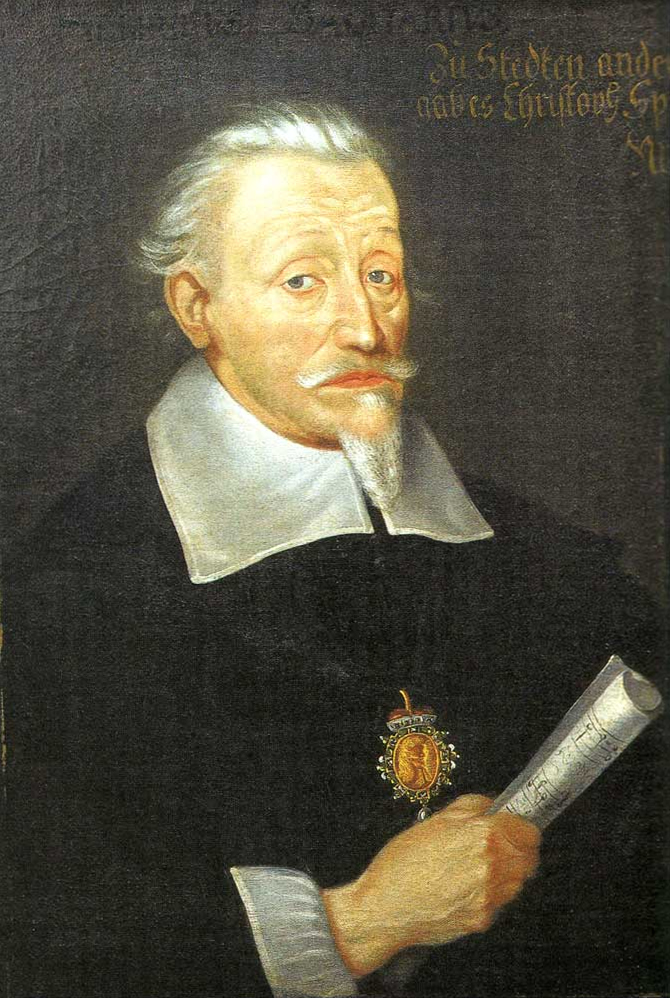Schütz, Alleluia: Lobet den Herren
 Psalm 150 catalogues the many instruments to be used in praising God: trumpets, lutes, harps, strings, pipes, drums, and cymbals. I suspect there was no intent to exclude others that didn’t make the list. The Psalm is an open invitation to composers, so let’s look at how the German composer Heinrich Schütz (1585-1672) took up the challenge.
Psalm 150 catalogues the many instruments to be used in praising God: trumpets, lutes, harps, strings, pipes, drums, and cymbals. I suspect there was no intent to exclude others that didn’t make the list. The Psalm is an open invitation to composers, so let’s look at how the German composer Heinrich Schütz (1585-1672) took up the challenge.
Schütz is credited with taking the new Italian Baroque style to Germany. Shortly after entering the University of Marburg in 1608, he was given a grant to spend two years in Venice studying with the elderly Giovanni Gabrieli (c. 1554/1557 – 1612). Gabrieli clearly had a strong influence, and Schütz stayed in Venice until Gabrieli’s death, after which he returned to Germany. We identify Gabrieli with antiphonal music, two ensembles that play alternately. Schütz scores this work for two four-voice choirs and two groups of instruments in four voices. The first instrumental group is made up of cornettos or violins with a fagotto (bassoon) or trombone bass. The second instrumental group consists of cornetto or flute on top with trombones on the other voices.
Lobet den Herren (Praise the Lord) begins and ends with an Alleluia. The Alleluia involves the entire ensemble in a homophonic (chordal) style in triple meter.
Each verse of the Psalm begins with Lobet den Herren (Praise the Lord) or Lobet ihn (Praise him).
1 Lobet den Herren, in seinem Heiligtum (in his sanctuary)
lobet ihn in der Feste seiner Macht (stronghold of his power)
Verse 1 (beginning at 0:42) is assigned to the soprano soloist in each ensemble accompanied by a solo bass line (fagotto or trombone). The basso continuo (a bass melodic instrument with choral accompaniment on lute or harpsichord) is present throughout, as is typical in all Baroque music. The soloists and small ensemble present the verse in a contrapuntal style, after which the entire ensemble (tutti) presents the verse in a more homophonic style. This pattern continues for each succeeding verse.
2 Lobet ihn in seinen Taten (for his deeds)
lobet ihn in seiner grossen Herrlichkeit (in his great glory)
Verse 2 (beginning at 2:00) is assigned to the alto soloists accompanied by the fagotto and cornetto (or violin) of each ensemble. Again, the small ensemble presents the verse contrapuntally followed by the entire ensemble in a more homophonic format.
3 Lobet ihn mit Posaunen (trumpets/trombones)
lobet ihn mit Psaltern und Harfen (psaltery and harp)
Tenor soloists present Verse 3 (at 3:18). In keeping with the text, the first instrumental ensemble is silent while the second group of instruments (made up of trombones) handles the accompaniment. The Psalm in English usually says trumpet, but Posaunen is the German word for trombone.
4 Lobet ihn mit Pauken und Reigen (drums and dancing)
lobet ihn mit Saiten und Pfeifen (strings and pipes)
As you no doubt expect, Verse 4 (at 5:25) goes to the basses, but Schütz introduces some other elements. While drums are not specified in the score, the melodic line becomes angular with repeated notes followed by an octave leap down. It has a percussive effect and, of course, the addition of drum in this performance is entirely appropriate. This section also switches to a contrasting triple meter. Further painting the text, the instrumental ensembles alternate solo flute and violin.
5 Lobet ihn mit hellen Cymbalen (bright cymbals)
lobet ihn mit wohlklingenden Cymbalen (euphonious cymbals)
Verse 5 (at 7:25) is given to pairs of soloists, soprano and tenor in each ensemble. Schütz does not indicate any percussion in the score. Cymbals were not a part of Renaissance and Baroque orchestras but came into vogue with Janissary (“Turkish”) music in the 18th century. Bells of all sizes were, of course, in use. Schütz does not indicate any percussion in the score. In fact, the instrumental ensembles are both silent (except for the continuo). So it seems that Schütz did not have in mind loud crashing cymbals as some English translations of the Psalm indicate, but rather the bright and euphonious cymbals of the German text.
6 Alles was Atem hat, lobe den Herrn. (All that have breath, praise the Lord.)
This final exhortation (at 8:06) directed at all who have breath naturally calls for the entire ensemble. The homophonic texture also results in all of them breathing together.



